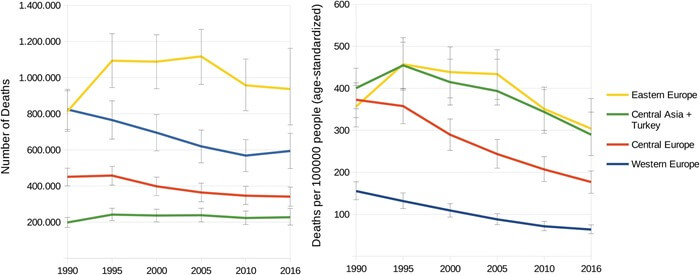The incessant "belt-tightening" makes its own adjustments not only to the purchasing possibilities of Russians, but also to their eating habits. You have to buy not what you want, but what is cheaper, albeit not very useful and of high quality.
However, malnutrition may not hit the wallet hard, but it does hit the cardiovascular system hard. This was proved by experts from the Friedrich Schiller University of Jena, who in 2019list of countries with the highest rate of deaths from malnutrition... Should we be proud that the first ten places in it went to the states that were previously part of the USSR?
Purpose and research methodology
The researchers were tasked with highlighting the link between certain dietary risk factors and cardiovascular disease (CVD) in the WHO European Region.
The experts used a group of indicators called the Global Burden of Disease Survey to estimate mortality from diet-related cardiovascular disease.
This estimate includes eleven forms of cardiovascular disease, twelve food and nutrient groups and 27 risk-outcome pairs in 51 European countries.
The 12 most important dietary factors for the development of heart and vascular problems include:
- a diet low in fiber;
- lack of fruit;
- lack of legumes;
- lack of nuts and seeds;
- lack of polyunsaturated fatty acids;
- lack of omega-3 fatty acids from seafood;
- lack of vegetables;
- lack of whole grains;
- a diet high in processed meat
- high sodium content;
- use sweetened drinks - some of the most harmful in the world;
- eating foods with trans fatty acids.
Consumption data were collected from several sources, including European nutrition studies, household budget studies, and UN Food and Agriculture Organization balance sheets and food supply bills. In addition, for sodium and trans fatty acids, data on the daily sodium content in urine and the presence of partially hydrogenated vegetable oil in packaged foods were used, respectively. All nutritional data (except sodium and sweetened beverages) have been standardized to 2000 kcal / day.
1990-2016 years were taken for the time period of the study.
Overall mortality rate due to malnutrition

Research results
The countries of the post-Soviet space are leading in mortality from pathologies of the heart and blood vessels associated with malnutrition. And the leader according to sad statistics is Uzbekistan (394 deaths per 100,000 people).
- The countries of Eastern Europe and Central Asia consistently have the highest mortality rates (average - 304 and 289 people per hundred thousand population, respectively). With the exception of Turkey, which has a dietary death rate of 67 per 100,000 people.
- In Central Europe (average 177 deaths per hundred thousand inhabitants), the rates ranged from 86 deaths per 100,000 population in Slovenia to 260 deaths per 100,000 population in Bulgaria.
- In Western Europe (mean 64 per 100,000 people), the highest rate was found in Greece (100 deaths per 100,000 inhabitants), and the lowest in Spain and Israel (43 cases per 100,000 people each).
- In the post-Soviet space, the best situation with proper nutrition is in Russia. In our country, so far the lowest mortality rate from heart and vascular diseases caused by errors in diet. It is 291 deaths per 100 thousand population.

How a balanced diet and CVD are related
In 2016, dietary risks were associated with 2.1 million deaths from cardiovascular disease in the WHO European Region. Here's how dietary risks have affected:
- A shortage of whole grains in the diet has resulted in an estimated 429,000 deaths.
- The second most dangerous is a shortage of nuts and seeds in the diet - 341,000 deaths.
- The third most dangerous is the lack of fruit - 262,000 deaths.
- High sodium diet is not good for the body - 251,000 deaths.
- And in the fifth place in danger was the lack of omega-3 fatty acids in the diet - 227,000 deaths.
Thus, by balancing the daily diet of Europeans, in theory, about one in every fifth premature death could be avoided.
As usual, the authors of the study have two news for readers - good and bad.
Good news: age-standardized mortality rates have declined over the past 26 years.
Bad news: the absolute number of diet-related deaths from cardiovascular disease increased from 2010 to 2016 by 25,600 deaths in Western Europe and 4,300 deaths in Central Asia.
In terms of specific cardiovascular diseases, 1.76 million deaths (84% of the total) attributable to dietary inaccuracies were due to coronary artery disease. It is followed by ischemic stroke (175,202 deaths or 8.3% of the total) and hemorrhagic stroke (132,749 deaths or 6.3%).
In 2016, approximately 601,000 deaths (28.6% of all food-related deaths from CVD) occurred among adults under 70 years of age. In simple terms: eat healthy food - you can live longer.

